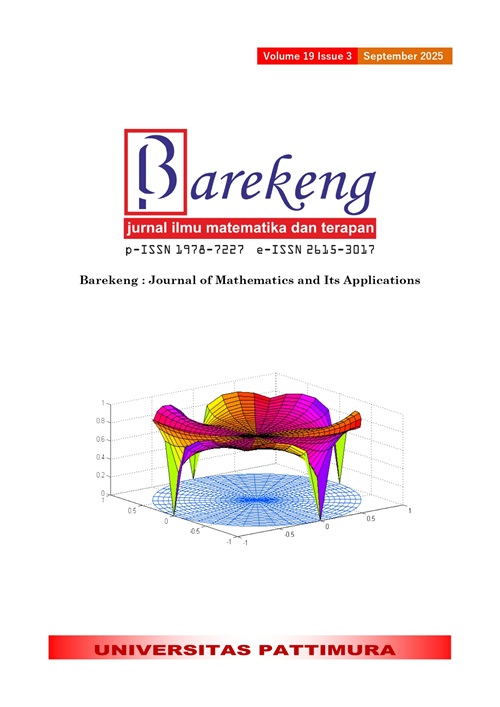OPTIMAL PORTFOLIO FORMATION USING MEAN VARIANCE EFFICIENT PORTFOLIO AND CAPITAL ASSET PRICING MODEL WITH ARTIFICIAL NEURAL NETWORK AS STOCK SELECTION METHOD
Abstract
There are two main things in forming an optimal stock portfolio: stock selection and stock weight determination. This study aims to determine the performance of an optimal portfolio formed using ANN as a stock selection method and MVEP (Mean-Variance Efficient Portfolio) and CAPM (Capital Asset Pricing Model) to determine stock weights. In addition, it is also necessary to determine the characteristics of the stocks formed in the portfolio. The criteria for stock selection are choosing stocks predicted to have maximum mean returns with minimal risk. This research uses data from 10 stocks listed on the Indonesian Stock Exchange. The forecasting results state that ANN can be used to predict stock prices to get a picture of stock prices in the future. Based on the calculation results, BMRI, TLKM, ASII, TPIA, and BBNI stocks were selected to form a stock portfolio. The MVEP and CAPM methods produce stock weights with different characteristics. The MVEP method gives the most significant weight to stocks that have the largest predicted mean return but experience changes in accuracy categories. The CAPM method gives the most significant weight to stocks with less risk than other stocks and has the smallest MAPE value. Empirically, ANN can be used to select stocks to form a portfolio. Stock price predictions with the most significant mean return and small risk can be used as a reference when forming a portfolio using the MVEP and CAPM methods.
Downloads
References
S. Syaripuddin, F. D. T. Amijaya, W. Wasono, S. Tulzahrah, and R. Suciati, “APPLICATION OF QUADRATIC PROGRAMMING ON PORTFOLIO OPTIMIZATION USING WOLFE’S METHOD AND PARTICLE SWARM OPTIMIZATION ALGORITHM,” BAREKENG: Jurnal Ilmu Matematika dan Terapan, vol. 18, no. 2, pp. 1067–1080, May 2024, doi: https://doi.org/10.30598/barekengvol18iss2pp1067-1080.
M. Purba, Sudarno, and Moch. A. Mukid, “OPTIMALISASI PORTOFOLIO MENGGUNAKAN CAPITAL ASSET PRICING MODEL (CAPM) DAN MEAN VARIANCE EFFICIENT PORTFOLIO (MVEP),” JURNAL GAUSSIAN, vol. 3, no. 3, pp. 481–490, 2014.
Sukono, K. Parmikanti, Lisnawati, S. Hersona, and J. Saputra, “MEAN-VAR INVESTMENT PORTFOLIO OPTIMIZATION UNDER CAPITAL ASSET PRICING MODEL (CAPM) WITH NERLOVE TRANSFORMATION: AN EMPIRICAL STUDY USING TIME SERIES APPROACH,” Industrial Engineering & Management Systems, vol. 19, no. 3, pp. 498–509, 2020.doi: https://doi.org/10.7232/iems.2020.19.3.498
Z. Wei, “FORECASTING WIND WAVES IN THE US ATLANTIC COAST USING AN ARTIFICIAL NEURAL NETWORK MODEL: TOWARDS AN AI-BASED STORM FORECAST SYSTEM,” Ocean Engineering, vol. 237, p. 109646, Oct. 2021, doi: https://doi.org/10.1016/j.oceaneng.2021.109646.
K. R. Prakarsha and G. Sharma, “TIME SERIES SIGNAL FORECASTING USING ARTIFICIAL NEURAL NETWORKS: AN APPLICATION ON ECG SIGNAL,” Biomed Signal Process Control, vol. 76, p. 103705, Jul. 2022, doi: https://doi.org/10.1016/j.bspc.2022.103705.
J. A. Fernandes de Souza, M. M. Silva, S. G. Rodrigues, and S. Machado Santos, “A FORECASTING MODEL BASED ON ARIMA AND ARTIFICIAL NEURAL NETWORKS FOR END–OF–LIFE VEHICLES,” J Environ Manage, vol. 318, p. 115616, Sep. 2022, doi: https://doi.org/10.1016/j.jenvman.2022.115616.
E. Ayyildiz, M. Erdogan, and A. Taskin, “FORECASTING COVID-19 RECOVERED CASES WITH ARTIFICIAL NEURAL NETWORKS TO ENABLE DESIGNING AN EFFECTIVE BLOOD SUPPLY CHAIN,” Comput Biol Med, vol. 139, p. 105029, Dec. 2021, doi: https://doi.org/10.1016/j.compbiomed.2021.105029.
D. Novita, T. Herlambang, V. Asy’ari, A. Alimudin, and H. Arof, “COMPARISON OF K-NEAREST NEIGHBOR AND NEURAL NETWORK FOR PREDICTION INTERNATIONAL VISITOR IN EAST JAVA,” BAREKENG: Jurnal Ilmu Matematika dan Terapan, vol. 18, no. 3, pp. 2057–2070, Jul. 2024, doi: https://doi.org/10.30598/barekengvol18iss3pp2057-2070.
J. Fu et al., “APPLICATION OF ARTIFICIAL NEURAL NETWORK TO FORECAST ENGINE PERFORMANCE AND EMISSIONS OF A SPARK IGNITION ENGINE,” Appl Therm Eng, vol. 201, p. 117749, Jan. 2022, doi: https://doi.org/10.1016/j.applthermaleng.2021.117749.
D. Supriyadi, P. Purwanto, and B. Warsito, “OPTIMIZING NEURAL NETWORKS FOR ACADEMIC PERFORMANCE CLASSIFICATION USING FEATURE SELECTION AND RESAMPLING APPROACH,” MENDEL, vol. 29, no. 2, pp. 261–272, Dec. 2023, doi: https://doi.org/10.13164/mendel.2023.2.261.
N. Lestari, I. Indahwati, E. Erfiani, and E. D. Julianti, “A COMPARISON OF ARTIFICIAL NEURAL NETWORK AND NAIVE BAYES CLASSIFICATION USING UNBALANCED DATA HANDLING,” BAREKENG: Jurnal Ilmu Matematika dan Terapan, vol. 17, no. 3, pp. 1585–1594, Sep. 2023, doi: https://doi.org/10.30598/barekengvol17iss3pp1585-1594.
P. Janků, Z. K. Oplatková, T. Dulík, P. Snopek, and J. Líba, “FIRE DETECTION IN VIDEO STREAM BY USING SIMPLE ARTIFICIAL NEURAL NETWORK,” Mendel, vol. 24, no. 2, pp. 55–60, 2018, doi: https://doi.org/10.13164/mendel.2018.2.055.
L. A. Laboissiere, R. A. S. Fernandes, and G. G. Lage, “MAXIMUM AND MINIMUM STOCK PRICE FORECASTING OF BRAZILIAN POWER DISTRIBUTION COMPANIES BASED ON ARTIFICIAL NEURAL NETWORKS,” Appl Soft Comput, vol. 35, pp. 66–74, Oct. 2015, doi: https://doi.org/10.1016/j.asoc.2015.06.005.
Y. Chaibi, M. Malvoni, T. El Rhafiki, T. Kousksou, and Y. Zeraouli, “ARTIFICIAL NEURAL-NETWORK BASED MODEL TO FORECAST THE ELECTRICAL AND THERMAL EFFICIENCIES OF PVT AIR COLLECTOR SYSTEMS,” Clean Eng Technol, vol. 4, p. 100132, Oct. 2021, doi: https://doi.org/10.1016/j.clet.2021.100132.
N. Hasan and R. I. Rasel, “ARTIFICIAL NEURAL NETWORK APPROACH FOR STOCK PRICE AND TREND PREDICTION,” in Conference: International conference on advanced information & communication technology, 2016.
L. Qian, J. Zhao, and Y. Ma, “OPTION PRICING BASED ON GA-BP NEURAL NETWORK,” Procedia Comput Sci, vol. 199, pp. 1340–1354, Jan. 2022, doi: https://doi.org/10.1016/j.procs.2022.01.170.
Y. Kara, M. Acar Boyacioglu, and Ö. K. Baykan, “PREDICTING DIRECTION OF STOCK PRICE INDEX MOVEMENT USING ARTIFICIAL NEURAL NETWORKS AND SUPPORT VECTOR MACHINES: THE SAMPLE OF THE ISTANBUL STOCK EXCHANGE,” Expert Syst Appl, vol. 38, no. 5, pp. 5311–5319, May 2011, doi: https://doi.org/10.1016/j.eswa.2010.10.027
D. Selvamuthu, V. Kumar, and A. Mishra, “INDIAN STOCK MARKET PREDICTION USING ARTIFICIAL NEURAL NETWORKS ON TICK DATA,” Financial Innovation, vol. 5, no. 1, 2019, doi: https://doi.org/10.1186/s40854-019-0131-7.
M. S. Farahani and S. H. R. Hajiagha, “FORECASTING STOCK PRICE USING INTEGRATED ARTIFICIAL NEURAL NETWORK AND METAHEURISTIC ALGORITHMS COMPARED TO TIME SERIES MODELS,” Soft comput, vol. 25, pp. 8483–8513, 2021, doi: https://doi.org/10.1007/s00500-021-05775-5.
A. H. Moghaddam, M. H. Moghaddam, and M. Esfandyari, “STOCK MARKET INDEX PREDICTION USING ARTIFICIAL NEURAL NETWORK,” Journal of Economics, Finance and Administrative Science, vol. 21, no. 41, pp. 89–93, Dec. 2016, doi: https://doi.org/10.1016/j.jefas.2016.07.002.
M. Li, “COMPREHENSIVE REVIEW OF BACKPROPAGATION NEURAL NETWORKS,” Academic Journal of Science and Technology, vol. 9, no. 1, pp. 150–154, Jan. 2024, doi: https://doi.org/10.54097/51y16r47.
B. H. An and J. W. Lee, “DEEP-LEARNING-BASED GENERATIVE DESIGN FOR OPTIMAL SILENCER USING BACKPROPAGATION OF ARTIFICIAL NEURAL NETWORK MODEL,” Advanced Engineering Informatics, vol. 62, p. 102763, Oct. 2024, doi: https://doi.org/10.1016/j.aei.2024.102763.
B. Wang and W. You, “Virtual Assembly Collision Detection Algorithm Using Backpropagation Neural Network,” Computers, Materials & Continua, vol. 81, no. 1, pp. 1085–1100, 2024, doi: 10.32604/cmc.2024.055538.
P. Wang et al., “REAL-TIME PREDICTION OF THE CHEMICAL OXYGEN DEMAND COMPONENT PARAMETERS IN ACTIVATED SLUDGE MODEL USING BACKPROPAGATION NEURAL NETWORK,” Heliyon, vol. 10, no. 16, p. e35580, Aug. 2024, doi: https://doi.org/10.1016/j.heliyon.2024.e35580.
X. Cai, S. Pang, M. Zhang, J. Teng, H. Lin, and S. Xia, “PREDICTING THERMODYNAMIC ADHESION ENERGIES OF MEMBRANE FOULING IN PLANKTONIC ANAMMOX MBR VIA BACKPROPAGATION NEURAL NETWORK MODEL,” Bioresour Technol, vol. 406, p. 131011, Aug. 2024, doi: https://doi.org/10.1016/j.biortech.2024.131011.
T.-A. Nguyen, H.-B. Ly, and B. T. Pham, “BACKPROPAGATION NEURAL NETWORK-BASED MACHINE LEARNING MODEL FOR PREDICTION OF SOIL FRICTION ANGLE,” Math Probl Eng, vol. 2020, pp. 1–11, Dec. 2020, doi: https://doi.org/10.1155/2020/8845768.
A. Singh, S. Kushwaha, M. Alarfaj, and M. Singh, “COMPREHENSIVE OVERVIEW OF BACKPROPAGATION ALGORITHM FOR DIGITAL IMAGE DENOISING,” Electronics (Basel), vol. 11, no. 10, p. 1590, May 2022, doi: https://doi.org/10.3390/electronics11101590.
H. Takizawa, T. Chida, and H. Kobayashi, “EVALUATING COMPUTATIONAL PERFORMANCE OF BACKPROPAGATION LEARNING ON GRAPHICS HARDWARE,” Electron Notes Theor Comput Sci, vol. 225, pp. 379–389, Jan. 2009, doi: 10.1016/j.entcs.2008.12.087.
A. Juliana, Hamidatun, and R. Muslima, MODERN FORECASTING TEORI DAN APLIKASI. Yogyakarta: Deepublish, 2019.
E. J. Elton, M. J. Gruber, S. J. Brown, and W. N. Goetzmann, MODERN PORTFOLIO THEORY AND INVESTMENTS ANALYSIS. 9th ed., no. 9. 2014.
Yahoo!Finance, “YAHOO FINANCE - STOCK MARKET LIVE, QUOTES, BUSINESS & FINANCE NEWS.” Accessed: Jul. 11, 2023. [Online]. Available: https://finance.yahoo.com/
IDX, “PT BURSA EFEK INDONESIA - INDONESIA STOCK EXCHANGE.” Accessed: Jul. 12, 2023. [Online]. Available: https://www.idx.co.id/id
BPS, “BI RATE - TABEL STATISTIK - BADAN PUSAT STATISTIK INDONESIA.” Accessed: Jul. 31, 2023. [Online]. Available: https://www.bps.go.id/id/statistics-table/2/Mzc5Iz
J. J. M. Moreno, A. P. Pol, A. S. Abad, and B. C. Blasco, “Using the R-MAPE index as a resistant measure of forecast accuracy,” Psicothema, vol. 25, no. 4, pp. 500–506, 2013, doi: 10.7334/psicothema2013.23.
Copyright (c) 2025 Emy Siswanah, Siti Maslihah, Agustina Anggraini, Muhammad Malik Hakim

This work is licensed under a Creative Commons Attribution-ShareAlike 4.0 International License.
Authors who publish with this Journal agree to the following terms:
- Author retain copyright and grant the journal right of first publication with the work simultaneously licensed under a creative commons attribution license that allow others to share the work within an acknowledgement of the work’s authorship and initial publication of this journal.
- Authors are able to enter into separate, additional contractual arrangement for the non-exclusive distribution of the journal’s published version of the work (e.g. acknowledgement of its initial publication in this journal).
- Authors are permitted and encouraged to post their work online (e.g. in institutional repositories or on their websites) prior to and during the submission process, as it can lead to productive exchanges, as well as earlier and greater citation of published works.






1.gif)



